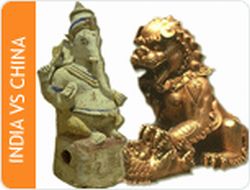
While China and India are touted as the new global economic super powers who would give the mighty Americans a run for their money but in reality, China and India are poles apart. The Foreign Direct Investments flowing into China is far greater than those making inroads into India are. Chinese infrastructure is far better than the potholed Indian roads and its undependable power supply. China with higher labor productivity than India is the world’s largest exporter of goods. India on the other hand with its large pool of trained human resource is the hotspot of IT industries, the global destination of business process outsourcing. Indian multinationals are far more aggressive than the Chinese indigenous companies are.
The difference between the two Asian super powers could be best explained by their cultural differences. Tarun Khanna, a professor at Harvard Business School has explained the cultural difference between the two countries as the probable reason of the different level and paces of economic growth in the two countries in his book – Billions of Entrepreneurs: How China and India Are Reshaping Their Future – And Yours. The political difference between the two countries – authoritarian China and democratic India – is always not necessary to explain the difference in attitude. China has always considered its diaspora as its own. In China, citizenship is determined by bloodline, whereas in India it is the place of birth that is more important; except for a few exceptions when a foreign-born individual married to a politically privileged family is considered suitable to adorn the prime ministerial office. The difference in diaspora management made all the difference in the rate of FDI flowing in the two countries. In the early years of globalization, 80% of China’s FDI came from the non-resident Chinese. It was only in 2002 that the Indian government started to court the Non-resident Indians or the NRIs to invest in India. In fact, the composition of the Indian and Chinese diaspora is quite different. The Indian diaspora consists of mostly professionals while the Chinese are largely entrepreneurs outside China.
Another glaring difference in the pattern of global influence exerted by the two countries as explained by Tarun Khanna is the Chinese emphasis on ‘hard power’ and India’s emphasis on ‘soft power’. All along India has remained complacent spreading their culture to the world. The soft powers are represented by the masala Bollywood movies, spiritual gurus and broader intellectual traditions. The Chinese hard power explains its ascent to Africa and even to the Wall Street that is a result of premeditated and orchestrated state policy.
Perhaps, India respects its domestic workforce more than China. This might explain why China has actively discouraged or undermined local entrepreneurship in favor of foreign direct investment- dependent approach. On the other hand, India is developing its infrastructure, may be at a snail’s speed, but the Indian system would allow indigenous enterprises to survive.




